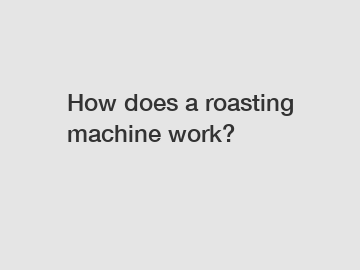How does a roasting machine work?
How does a roasting machine work?
Roasting machines have become essential in the process of turning raw coffee beans into the fragrant and flavorful beverage we all enjoy. To understand how these machines work, we need to delve into the intricacies of the roasting process itself.
The first step in understanding a roasting machine's operation is to recognize that coffee beans undergo a series of physical and chemical transformations during the roasting process. As the temperature rises, the moisture within the beans evaporates, causing them to dry out and become more brittle. This leads to the beans undergoing a color change, from green to yellow, and eventually to brown, as they start to develop their characteristic aroma and flavors.

A roasting machine facilitates this process by providing controlled heat to the coffee beans. The machine employs a combination of direct and indirect heat sources to ensure uniform roasting. The direct heat typically comes from a gas burner or electric coil located within the machine. It heats the air surrounding the beans, causing them to gradually increase in temperature.
Simultaneously, the indirect heat in the form of hot air circulates within the roasting chamber, enveloping the beans in an even heat distribution. This helps prevent any scorching or uneven roasting, ensuring that all beans are roasted consistently.
The temperature inside the roasting machine is carefully monitored and controlled throughout the process. It follows a precise roasting profile based on the desired roast level. Different roast levels bring out different flavors in the coffee, ranging from light or medium roasts with more acidity and floral notes, to dark roasts with robust and bold flavors.
The roasting process also involves a series of chemical reactions known as the Maillard reaction and caramelization. These reactions occur between the amino acids and sugars present in the coffee beans, resulting in the development of complex flavors and aromas. The duration of the roasting process affects the intensity of these reactions and ultimately determines the flavor profile of the coffee.
Understanding how a roasting machine works is crucial because it allows coffee roasters to have precise control over the roasting process. By adjusting variables such as temperature and duration, roasters can experiment with different profiles to create unique and distinctive flavors. This level of control is particularly important in the specialty coffee industry, where roasters strive to highlight the inherent qualities of each coffee bean variety.
In addition to the quality aspect, the operation of a roasting machine also impacts the production efficiency of coffee roasters. By automating the roasting process, machines can ensure a consistent and reliable output, reducing the chance of human error. This not only saves time but also allows roasters to focus on other aspects of coffee production, such as sourcing and cupping.
In conclusion, a roasting machine utilizes a combination of direct and indirect heat sources to transform raw coffee beans into the aromatic and flavorful coffee we love. By understanding the intricacies of the roasting process and the role of a roasting machine in facilitating it, coffee roasters can achieve consistent quality and explore a vast range of flavors. The development and innovation of roasting machines have revolutionized the coffee industry, enabling roasters to showcase the diversity and nuances of coffee beans from around the world.
For more vegetable screw press machine exporter, electromagnetic roasting machine supplier, vacuum vegetable oil refinery machineinformation, please contact us. We will provide professional answers.
191
0
0

Comments
All Comments (0)